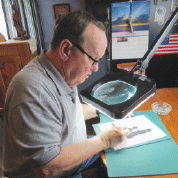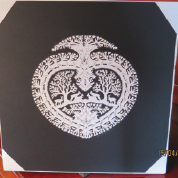
mountain talk
Army Chaplain, Family Man, Pastor, and Artist
by Chris O’Connor Col. Bill Hammann of Blue Ridge Summit retired in 1999 after two and a half decades in the U.S. Army, where he served as a chaplain, rising through the ranks, ministering to the spiritual needs of American patriots and their families. His service to our nation spanned the Cold War years, continuing throughout Desert Storm and Desert Shield. He was stationed in Germany just prior to the fall of the Berlin Wall—something he thought would never happen during his lifetime. He was stationed at bases from Korea to Germany, as well as stateside posts, including Ft. Hood in Texas, Ft. Sill in Oklahoma, Ft. Knox in Kentucky, and the Presidio in California. After retirement, he returned to Pennsylvania, because he has family in Carlisle. Now he is in what he jokingly calls his “second retirement,” after serving as pastor at Hawley’s Memorial Presbyterian Church in Blue Ridge Summit. The decision to retire didn’t come easily, for he grew to love his congregation over a span of ten years. His family was the main driver of his difficult choice. He and his wife Lucy have a blended brood of six children and ten grandchildren, with whom they want to spend more time. Though some might question if Bill isn’t already entrenched in a third career, for he has grown quite accomplished in the centuries-old German form of artistic expression called scherenschnitte or “scissors cutting,” brought to our shores by German immigrants who settled mostly in colonial Pennsylvania. Sherenschnitte—in its simplest form—is most easily described as silhouettes or stencil-like patterns cut from paper. The colonists used them as a means to decorate their homes for things such as shelf liners, doilies, birth and wedding announcements, or other embellishments to enhance the home environment. The colonial style designs were more simplistic by virtue of the available tools of that time. Many sherenschnitte designs, such as heart-shaped ones, predated our modern valentines, with space left in the center for messages penned in calligraphy. Its modern incarnation is elaborate, intricately detailed works of art depicting a limitless variety of subjects, where the artist is only limited by his or her imagination. Bill decided to learn the art form following his retirement from the Army in 1999 at the urging of his brother, who had acquired some pieces by other artists. Bill acquired some books and dove right in. While many might consider patience the requisite to create such intricate pieces, Bill saw it differently and, in fact, found it relaxing and therapeutic. He had lingering back pain resulting from a Jeep rollover accident that occurred while he was still in the Army, and the pain often left him sleepless. Working on his earliest pieces were painstaking in more ways than one, helping distract him from the discomfort of his injury. Bill is concerned that scherenschnitte is becoming a lost art. He is proud that some members of his family are continuing in the tradition. He has also held classes at Renfrew and a group at his church. Anyone with an interest in the art form should start with simple designs and scissors, or Bill’s cutting tool of choice, an X-Acto knife. His best advice is to have an ample supply of sharp blades available. As soon as the blade begins to pull the paper while cutting, change the blade. Besides the paper used for the design and knife blades, supplies are largely minimal. Early on, Bill used old catalogs as cutting mats. While it was a creative way to protect the tabletop, it was arguably a false economy since extra layer of catalog pages further dulled the knife blades, not to mention the wee bits of catalog paper that had to be cleaned up. Chasing infinitesimal bits of catalog pages was something akin to herding cats, sweeping down from a pillow with a hole in it while a ceiling fan’s going, or like raking dry autumn leaves in shifting winds. Bill is not chasing bits of old catalogs these days. He uses a so-called “self-healing” mat as a base for his paper cutting. The paper rests on its stable surface and protects both the tabletop and also lengthens the life of the cutting blade. To enable Bill to make the extremely miniscule cuts on his most-detailed designs, he acquired an architectural lamp, a high-powered magnifying glass with a light that clamps on the side of his table and brightly illuminates his work surface. Another technique he has recently chosen to implement in his work is “pin-pricking,” where pins of varying gauges are used to augment dimension and texture of the original design. Having seen an extensive array of Bill Hammann’s exquisite art work, learned about his early service in gang ministry, about his striving to help dropouts before he joined the Army, his service to our military for over two decades, all followed by his jumping back into civilian life and striving to enhance folks spiritual life yet more…I’m left wondering, “Who does all that?” That would be Col. Bill Hammann: U.S. Army (Ret.), parent, pastor, patriot…and artist, here on the Mountain. That would be Col. Bill Hammann: U.S. Army (Ret.), parent, pastor, patriot…and artist, here on the Mountain. Col. Bill Hammann can be reached via email at [email protected]. Bill Hammann is shown working on a silhouette scherenschnitte art piece.
Photo by Chris O’Connor
Bill Hammann is shown working on a silhouette scherenschnitte art piece.
Photo by Chris O’Connor

Pictured is one of Bill Harmmann’s detailed and intricate pieces of scherenschnitte art work.
Photo by Bill Hammann